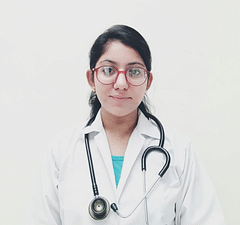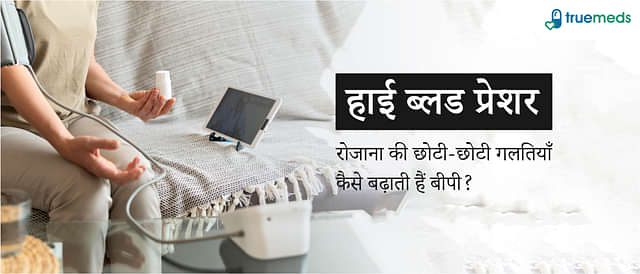Shortness of Breath: Symptoms, Causes, Treatment & Home Remedies
Last updated on : 01 Dec, 2025
Read time : 10 min
Shortness of breath, medically known as dyspnoea, is a common symptom with a wide range of underlying causes from heart and lung conditions to anxiety and physical exertion. It is a widely reported symptom; in some emergency department settings, it accounts for up to 30% of all presentations [2].
Understanding the causes, recognising the symptoms, and knowing when to seek help is essential for effective management. This article explores what shortness of breath is, its common causes, symptoms, and both medical and supportive home-based remedies for symptom relief, along with vital information on when to consult a doctor.
What is Shortness of Breath (Dyspnoea)?
Shortness of breath is the terrifying and uncomfortable feeling of not being able to get enough air into your lungs. It can manifest as chest tightness, gasping for air, or working harder to breathe, and is often a symptom of underlying heart or lung problems. Recognising the signs and symptoms is vital for seeking appropriate medical attention and treatment, as severe dyspnoea can indicate an emergency [3].
Common Symptoms of Dyspnoea
Shortness of breath can present with several distinct symptoms, each indicating different potential causes.
1. Laboured Breathing
- Difficulty breathing when resting or performing daily tasks
- Feeling like you need to work harder to breathe
- May be accompanied by feelings of anxiety and fatigue
2. Rapid Breathing (Tachypnea)
- Breathing at a faster rate than normal
- It can be a response to physical exertion, illness, or anxiety
- May indicate an underlying medical condition, such as asthma or Chronic Obstructive Pulmonary Disease (COPD)
3. Chest Tightness or Pain
- Feeling of tightness or pain in the chest
- This can be a sign of serious, potentially life-threatening conditions like a heart attack, pulmonary embolism, or interstitial lung disease, especially when accompanied by other symptoms like palpitations or dizziness [4].
4. Wheezing or Coughing
- Wheezing sounds when breathing out (A whistling sound when exhaling)
- Coughing, which may produce mucus
- Common in conditions like asthma, COPD, and pneumonia
5. Fatigue or Weakness
- Feeling unusually tired or weak
- It can be due to insufficient oxygen reaching the body’s tissues
- Often seen in chronic conditions like heart failure and lung diseases
6. Inability to Engage in Physical Activity
- Difficulty performing physical activities due to breathlessness
- May indicate chronic conditions such as COPD or heart failure
- Can significantly impact quality of life
Common Causes of Dyspnoea
Shortness of breath can be caused by a wide range of conditions.
1. Respiratory Conditions
- Asthma: Reversible inflammation and constriction in the airways
- Chronic Obstructive Pulmonary Disease (COPD): Irreversible damage to the breathing tubes and lung tissue
- Pneumonia: Infection in the lungs, causing inflammation and fluid buildup
- Interstitial Lung Disease: Damage to lung tissue from various causes
2. Cardiovascular Causes
- Heart Attack: Reduced blood flow can lead to fluid backup in the lungs, making it difficult to breathe
- Heart Failure: Inability of the heart to pump enough blood, causing breathlessness and fatigue (Diagnosis is complex and may involve advanced testing) [5].
- Pulmonary Embolism: A Blood clot in an artery to the lung
3. Anxiety and Panic Disorders
- Anxiety Attacks: Can cause rapid, shallow breathing and feelings of being smothered or suffocated [6].
- Panic Disorder: Recurring panic attacks that can lead to shortness of breath
4. Other Medical Conditions
- Obesity: Excess weight can strain the lungs and heart, leading to shortness of breath (Excess body fat can impair diaphragm and chest wall movement) [7].
- Anaemia: Low red blood cell count or haemoglobin level, reducing oxygen delivery to tissues
- Foreign Objects Obstructing Airways: Blockage in the airways can cause sudden shortness of breath
Medical Management for Dyspnoea
Addressing shortness of breath requires diagnosing and treating the underlying cause, which may involve:
- Medications: Such as bronchodilators for asthma, diuretics for heart failure, and antibiotics for infections.
- Oxygen Therapy: To increase oxygen levels in the blood in cases of hypoxia.
- Surgery: For conditions like structural heart disease, chronic blood clots, or severe emphysema.
- Breathing Exercises: Often taught by physiotherapists, these techniques can help manage symptoms, especially in chronic lung diseases.
Supportive Home Remedies for Symptom Relief
Home remedies should only be used to support prescribed medical treatment and should never replace professional medical care, particularly for acute or severe dyspnoea. These techniques primarily aim to calm the respiratory system and manage anxiety.
- Pursed-Lip Breathing: A specific technique where you inhale slowly through the nose and exhale slowly through pursed lips, which helps slow down the breathing rate and keep airways open longer.
- Relaxation Techniques: Meditation, yoga, or progressive muscle relaxation can help reduce anxiety and panic, which often exacerbate feelings of breathlessness [6].
- Elevate Your Head: When sleeping, use extra pillows to elevate your head and chest, which can help reduce the fluid pressure in the lungs associated with conditions like heart failure, easing nocturnal breathing difficulties.
- Stay Hydrated: Drink plenty of water to thin out mucus and keep airways clear, making it easier to clear the lungs.
- Avoid Triggers: Stay away from allergens, pollutants, and irritants (like strong chemical smells or cold air) that can exacerbate respiratory conditions.
Preventing Shortness of Breath
Preventing breathlessness largely involves managing health and environmental risks:
- Engage in regular moderate exercise to help improve lung capacity and support heart health.
- Maintain a healthy weight through a balanced diet to avoid obesity and related respiratory issues [7].
- Quit smoking and avoid exposure to secondhand smoke to help reduce the risk of lung damage and improve overall respiratory health.
- Practice relaxation techniques like meditation and deep breathing to manage stress.
- Take precautions to avoid inhaling pollutants, chemicals, and dust (e.g., wearing a mask in polluted environments).
Risk Factors of Shortness of Breath
Several factors can contribute to an increased likelihood of experiencing shortness of breath:
- Lifestyle: Being overweight, smoking, and leading a sedentary lifestyle with minimal exercise can all heighten the risk.
- Pre-existing Conditions: Pre-existing heart or lung conditions, such as asthma, COPD, and heart failure, also play a significant role.
- Environmental Exposures: Exposures to pollutants, chemicals, and dust can exacerbate the condition.
- Genetic Factors: A family history may influence the development of emphysema and early-onset cardiac diseases.
If you suspect that you may be at risk for shortness of breath, it is crucial to consult a healthcare professional for a proper diagnosis.
Diagnosis of Dyspnoea
Diagnosis of dyspnoea will entail a comprehensive approach:
- Medical History: Providing a detailed medical history, including symptoms and lifestyle factors.
- Physical Examination: Undergoing a physical examination to assess vital signs and lung and heart sounds.
- Imaging: Chest imaging, such as X-rays, CT scans, or MRI, to evaluate lung and heart structures.
- Pulmonary Function Tests (PFTs): To measure lung capacity and efficiency.
- Echocardiogram: To assess heart function.
- Cardiopulmonary Exercise Testing (CPET): Advanced testing often reserved for unexplained cases, measuring oxygen utilisation and heart and lung function during exercise [8].
When to Contact a Doctor
Immediate medical attention is required for:
- Severe or sudden onset of shortness of breath [9].
- Chest pain or discolouration of your skin or lips (cyanosis).
- Inability to function normally due to breathlessness.
Consult your doctor for further evaluation if you experience:
- Worsening shortness of breath during routine activities.
- Swollen ankles (oedema).
- A persistent cough.
Conclusion
Shortness of breath can be a signal of serious medical issues, from asthma and lung infections to heart failure and pulmonary embolism. Knowing the causes, symptoms, and when to seek medical care is vital. Although breathing exercises and home remedies can be used as complementary methods to support medical treatment, never ignore persistent or severe symptoms. Timely diagnosis and proper management can greatly improve both quality of life and long-term outcomes. If you are concerned about your breathing, consult a healthcare professional immediately.
Frequently Asked Questions (FAQs)
What is the main reason for shortness of breath?
The main reason for shortness of breath (dyspnoea) is often related to heart or lung conditions, such as asthma, heart failure, or chronic obstructive pulmonary disease (COPD).
What are the three types of shortness of breath?
Clinically, dyspnoea can be categorised by its onset and duration, including acute dyspnoea (sudden onset), chronic dyspnoea (lasting several weeks or longer), and paroxysmal nocturnal dyspnoea (occurring at night) [9].
Can shortness of breath be cured naturally?
No. While lifestyle changes and home remedies can significantly manage and alleviate symptoms, particularly those related to mild conditions or anxiety, most underlying causes of chronic or severe shortness of breath require specific medical treatment from a healthcare professional. Natural methods are supportive, not curative.
What should one not eat when experiencing shortness of breath?
It is generally advised to avoid foods that can trigger allergies or exacerbate conditions like asthma or COPD, such as highly processed foods, foods high in salt (which can lead to fluid retention), and those that cause excessive inflammation. Eating smaller, more frequent meals can also prevent the stomach from pressing on the diaphragm.
Is shortness of breath a serious problem?
Yes, shortness of breath is a serious problem, and its sudden or severe onset requires immediate medical evaluation, as it can indicate underlying health issues such as heart failure, pulmonary embolism, or severe infections.
What is the best test for shortness of breath?
The diagnostic approach is guided by the patient’s symptoms and history. Common initial tests include a chest X-ray, electrocardiogram (ECG), and blood tests to measure oxygen saturation. Pulmonary function tests (PFT) and an echocardiogram may also be necessary depending on the suspected cause.
How does one fight winter breathing problems?
To fight winter breathing problems, maintain a warm and humid environment, avoid cold air by wearing a scarf over your mouth and nose, use a humidifier, and follow your doctor’s advice on managing underlying conditions like asthma or COPD.
How can one improve their shortness of breath?
Improving shortness of breath involves addressing the underlying cause with medical treatment, quitting smoking, losing weight (if necessary), avoiding allergens and irritants, performing regular exercise, and using breathing techniques learned from a specialist.
References
[1] Patient Safety Team. (n.d.). Talking to your doctor. Agency for Healthcare Research and Quality. Retrieved October 30, 2025, from https://www.ahrq.gov/patients-safety/getting-health-care/patient-involvement/talkingtoyourdoc.html
[2] Barnett, L. A., Prior, J. A., Kadam, U. T., & Jordan, K. P. (2017). Chest pain and shortness of breath in cardiovascular disease: a prospective cohort study in UK primary care. BMJ Open, 7(5), e015857. https://doi.org/10.1136/bmjopen-2016-015857
[3] Stuart-Harris, C. H. (1964). Shortness of breath. British Medical Journal, 1(5392), 1203–1207. https://doi.org/10.1136/bmj.1.5392.1203
[4] Binks, A. P. (2022). Dyspnea. In M. D. F. V. de Visser, T. G. V. W. van Duijn & S. T. M. L. E. A. Visser-Vandewalle (Eds.), Handbook of Clinical Neurology (Vol. 188, pp. 309–338). Elsevier. https://doi.org/10.1016/B978-0-323-91534-2.00008-4
[5] Diagnosis of Heart Failure With Preserved Ejection Fraction Among Patients With Unexplained Dyspnea. (2022). JAMA Cardiology, 7(8), 841–849. https://jamanetwork.com/journals/jamacardiology/fullarticle/2793877
[6] Kozik, T. M., Pelter, M. M., Al-Zaiti, S. S., & Carey, M. G. (2012). Sudden shortness of breath and anxiety. American Journal of Critical Care, 21(6), 453–454. https://doi.org/10.4037/ajcc2012216
[7] Gibson, G. (2000). Obesity, respiratory function and breathlessness. Thorax, 55(Suppl 1), S41–S45. https://doi.org/10.1136/thorax.55.suppl_1.s41
[8] Santus, P., Radovanovic, D., Saad, M., Zilianti, C., Coppola, S., Chiumello, D. A., & Pecchiari, M. (2023). Acute dyspnea in the emergency department: a clinical review. Internal and Emergency Medicine, 18(5), 1491–1507. https://doi.org/10.1007/s11739-023-03322-8
Disclaimer
Our healthcare experts have carefully reviewed and compiled the information presented here to ensure accuracy and trustworthiness. It is important to note that this information serves as a general overview of the topic and is for informational purposes only. It is not intended to diagnose, prevent, or cure any health problem. This page does not establish a doctor-patient relationship, nor does it replace the advice or consultation of a registered medical practitioner. We recommend seeking guidance from your registered medical practitioner for any questions or concerns regarding your medical condition.
Popular Articles
Recommended Articles
Recent Articles
Company
About UsHealth ArticleHealth StoriesHealth LibraryDiseases & Health ConditionsAyurvedaUnderstanding Generic MedicinesAll MedicinesAll BrandsNeed HelpFAQSecuritySubscribe
Registered Office Address
Grievance Officer
Download Truemeds
Contact Us
Our customer representative team is available 7 days a week from 9 am - 9 pm.
v4.11.0
2026 - Truemeds | All rights reserved. Our content is for informational purposes only. See additional information.
Our Payment Partners














































